Some of us more than others pay attention to punctuation: Folgers or Folger’s?
However, we all recognize a rhyme when we hear it:
The best part of waking up
Is Folgers in your cup!
My first major (masked) voyage after the unexpected onset and unchartered course of Covid 19 was in July 2021 from Dulles to San Francisco airport to visit my family. First item on the agenda the day after arriving: my son drove us 7 minutes from his house in San Carlos to visit the historic Filoli estate, one of 28 sites of The National Trust for Historical Preservation. My daughter who lives in San Jose loved the gardens and grounds so much that on the spot she joined as a member. And what a nice surprise was waiting for me in the pantry!
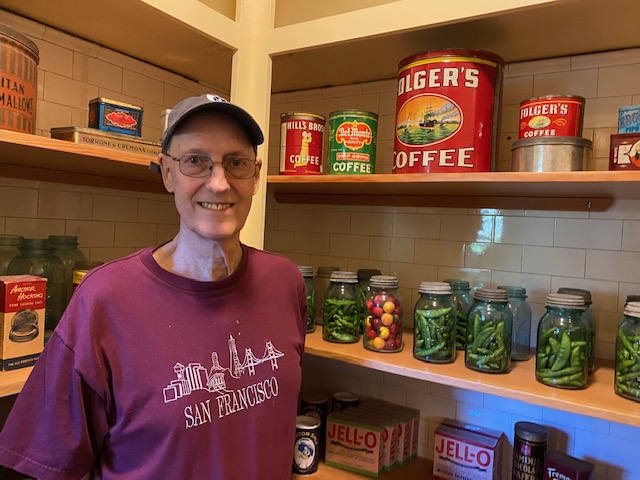
Fig. 1. Filoli pantry, Folger’s coffee cans, and thrilled author
Jason Hinkle, the Director of Visitor Services at Filoli, exclaimed to us excitedly, “Wait until you hear how we got those old coffee cans!” I had assumed they had lain for decades on the estate pantry shelf. It took me a while to get the full scoop. You would not guess it, Filoli stands for FIght LOve LIve.
Julie Bly DeVere, Director of Museum Collections at Filoli, put the word out that she needed a refrigerator to complete their vintage kitchen appliance set. Curator of Collections at History San Jose, Ken Middlebrook, responded that they could spare a duplicate General Electric refrigerator. When Julie masked up and toured the San Jose facility to check out the fridge, she spied two (empty) vintage Folger’s coffee cans. One was a whopper fifteen pounder! They were available, too. Julie later wrote me, “I was thrilled to have a can that was big enough for our pantry!”
Mind you, a sealed Folger’s coffee can might have been full of something other than coffee. Today eBay will sell you a Folger’s coffee jigsaw puzzle in a can, a promotional item. “Pull string to open” are the instructions to get into the look-alike cardboard container. EBay will also sell you various vintage cans of Folger’s coffee.
Let’s look closely at the two Folger’s coffee cans.
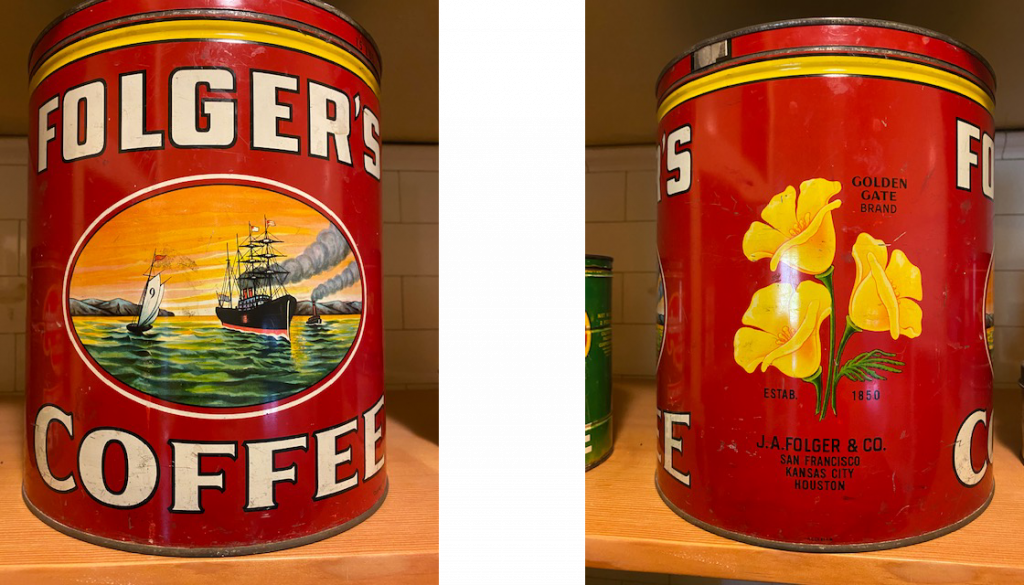
Figs. 2-3. 15-lb Folger’s can
FOLGER’S COFFEE 15 LBS. NET WEIGHT GOLDEN GATE BRAND ESTAB. 1850
J. A. FOLGER & CO. SAN FRANCISCO KANSAS CITY HOUSTON
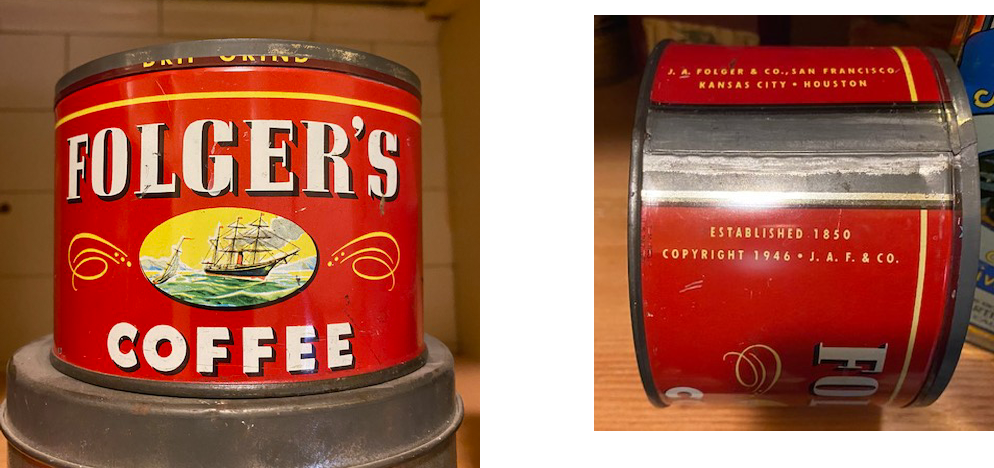
Figs. 4-5. Smaller Folger’s tin
FOLGER’S COFFEE DRIP GRIND
ESTABLISHED 1850 COPYRIGHT 1946 J. A. F. & CO
J. A. FOLGER & CO. SAN FRANCISCO KANSAS CITY HOUSTON
Folger’s Coffee has now been around for 171 years. As of 1946 (written on Fig. 5. can), we learn that Folger’s label included an apostrophe after Folger, as in Folger’s Coffee. The company was founded in San Francisco, and by 1946 had expanded to have plants/offices in Kansas City and Houston. “Drip grind” indicates a fine grind of coffee, whereby the brew drips through a filter. “Golden Gate brand” was the most expensive blend of ground coffee.
Let’s appreciate the evocative artistry on the coffee cans. In the background, you have the Golden Gate Bay entrance with, on one side, the Marin Headlands, and, on and the other, San Francisco. In the foreground, to the left, a pilot schooner; the center, a four-masted square-rigged ocean freighter powered by sail and steam; and to the right, a steam-powered tugboat. The freighter illustrates the means by which bags of green coffee beans, in the Age of Sail, traveled from distant shores in Central and South America.
For the historical context behind the Folger memorabilia, we turn to a 72-page pamphlet, The Folger Way: Coffee Pioneering Since 1850, written by Ruth Waldo Newhall. For those that may be interested, according to WorldCat.org––the world’s largest library catalog––four editions of The Folger Way were published between 1961 and 1970.
1961 by J. A. Folger & Co., San Francisco, print and ebook
1963 by Folger Coffee Co., Cincinnati, print
1970 by J. A. Folger & Co., San Francisco, print.
The copy of The Folger Way that I read in 2010 was in the California Historical Society library in San Francisco. You can see the call number, N455 in the following image.
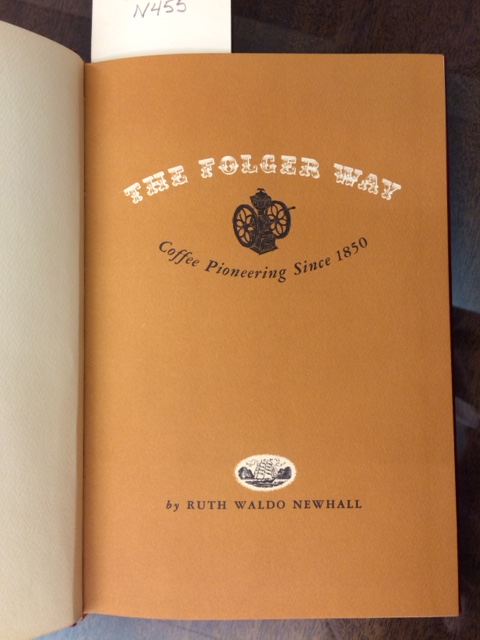
Fig. 6. The Folger Way: Coffee Pioneering Since 1850 by Ruth Waldo Newhall
Note that the 1963 edition was printed in Cincinnati because that city was where Procter & Gamble was headquartered. 1963 was the year when P&G acquired J. A. Folger & Co. It was Procter & Gamble who decided to change “Folger’s” to “Folgers” in the brand. I did not try to track down the minutes of the P&G Executive Committee to learn when the change was made and why.
The pamphlet starts by evoking the New World’s first Peter Folger, who in 1635 sailed on the Abigail to the New World with his father John from East Anglia, eastern England. This Peter Folger was a polymath par excellence, but still, much less well known than his grandson, Benjamin Franklin. You can read about it in this journal article I wrote in 2016.
The Folger Way continues by describing the tragedies that befell Samuel Brown Folger (1795–1864), master blacksmith in Nantucket, who owned two ships and headed a shop that outfitted shipbuilders and owners. In 1844, his third of nine children Samuel Jr. died at age 19. In 1846, a fire destroyed the waterfront and business quarter, including Samuel’s shop and ships. His remaining five sons aged 9 to 19 pitched in to help in the rebuilding effort. Henry Clay Folger Sr., father of the founder of the Folger Shakespeare Library in 1932, was one of them at age 13; James Ahearn Folger was another, the next to youngest at 11. The downtrodden family saw a glimmer of hope at the end of the decade: gold on the west coast.
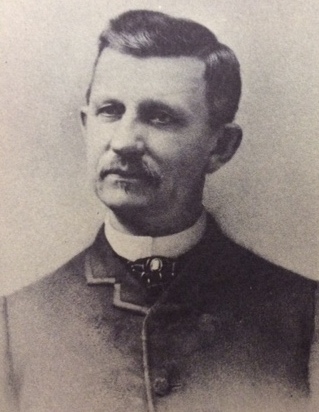
Fig. 7. James Ahearn Folger
The Folger Way, p33
James Ahearn Folger (1835–1889) was born in Nantucket when the island boasted the largest whaling port in the world. By his 15th year, the whaling trade had plummeted, sending him searching for a different livelihood. Fourteen Pacific Mail steamers left Nantucket for the Isthmus of Panama, and on to disgorge laborers and fortune seekers to participate in The California Gold Rush. On May 5, 1850, James and two older brothers entered the Golden Gate. Family funds allowed for only two to try their luck at gold; James would fend for himself relying on his carpentry skills.
Almost twice Jim’s age, William Henry Bovee had established a small coffee roasting business in New York City. When William arrived in San Francisco he hired Jim to help build a spice and coffee mill. Housewives were making their own coffee at home. Before long, Jim became clerk and salesman in the first mill in California to roast, grind, and package coffee.
In 1861––wartime––James Folger married Ellen Laughren of Burlington, Vermont who had traveled to San Francisco with her parents. James II was born in 1863. The family settled in Oakland. Four more children were born, and two died. James II, Elizabeth, and Ernest lived until adulthood. James entered into various partnerships until 1880. After one went bankrupt in 1865, he managed to pay off the debts. In the 1880s salesmen from the firm scoured rough-and-tumble lumber and mining towns in the west and northwest as far as Seattle. To coffee products they added spices, tea, baking powder, and extracts. Periodically James returned to his beloved Nantucket in the summer.
James became a prosperous Oakland citizen. He joined the Bohemian and Pacific Union Clubs. He served on Oakland’s Board of Education and City Council. In June 1889, the Folgers left for a summer vacation in Monterey. He developed acute gastritis and at 54 died unexpectedly of a coronary occlusion. Oakland city flags were flown at half-mast.
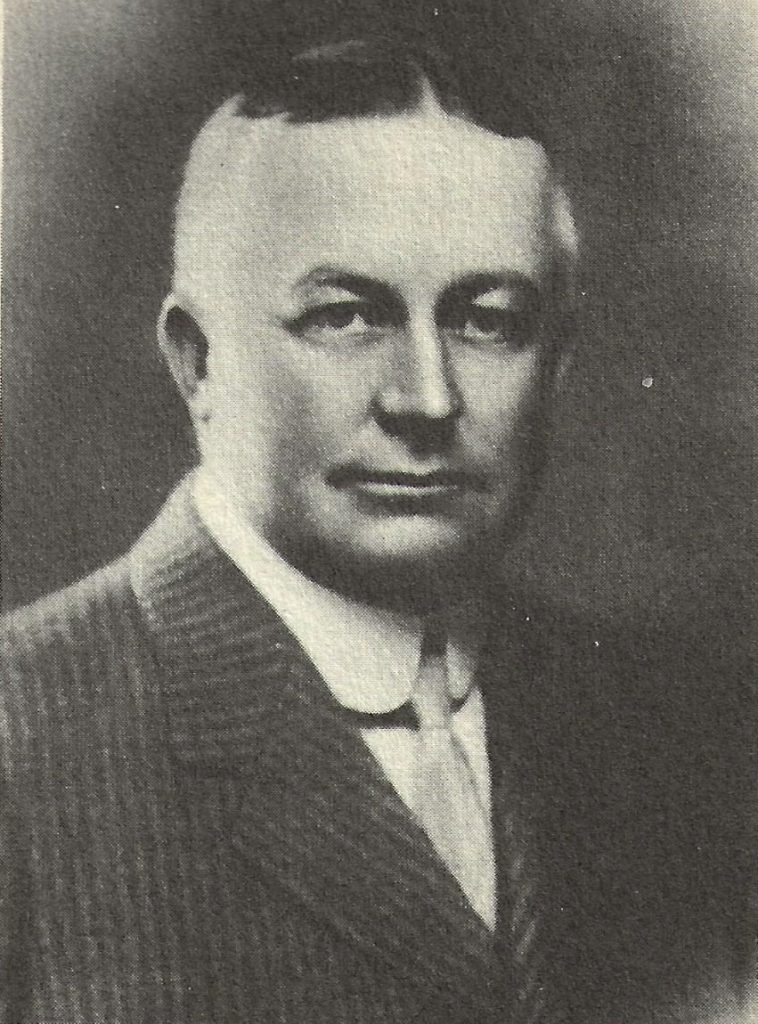
Fig. 8. James Ahearn Folger II
The Folger Way, p34
At age 26, having worked seven years in the firm as clerk and salesman, James Ahearn Folger II (1863–1921) stepped into his father’s shoes as the second-generational President of J. A. Folger & Co. The estate included total ownership of J. A. Folger & Co. In 1890, James A. Folger II filed papers of incorporation: James II, Ernest, and Elizabeth each held one-third of the stock.
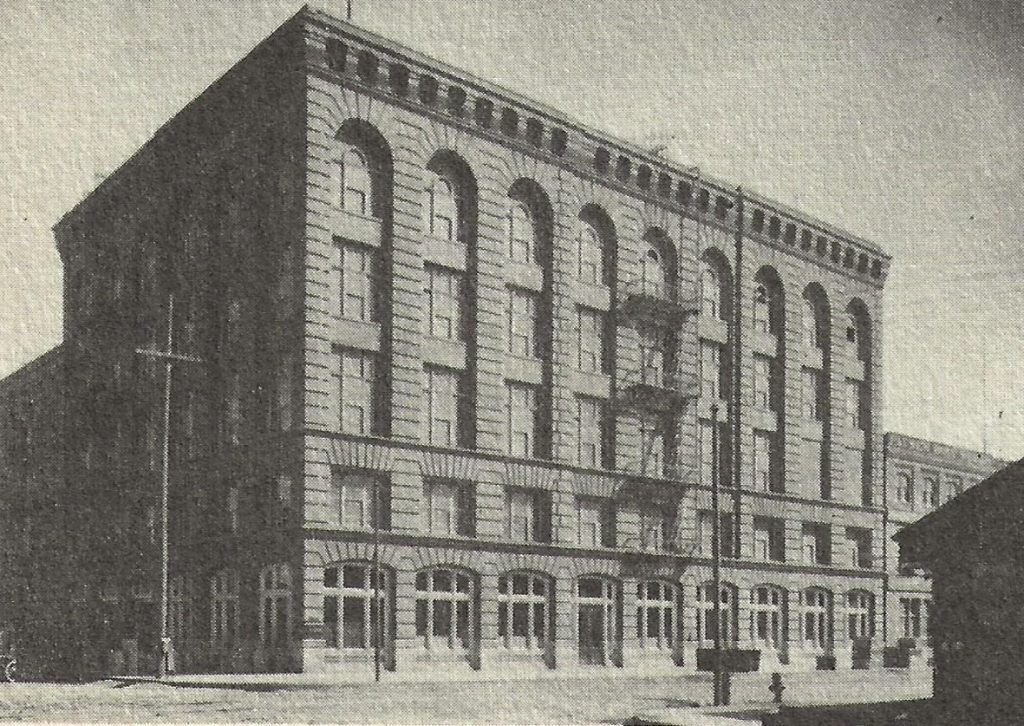
Fig. 9. Folger’s Coffee office and plant completed in 1905, The Folger Way, p42
1905 was a big year for Folger’s coffee. The company chose the corner of Howard and Spear Streets in San Francisco to build a ground-floor office with four upper floors for the plant. It was choice real estate in the city: a block and a half from the bay piers and three blocks from the Ferry building. The location served the firm until 1963. Today the ground floor is occupied by an optometrist’s office. The University of San Francisco owns floors 2–5 that are used for classes as well as administration.
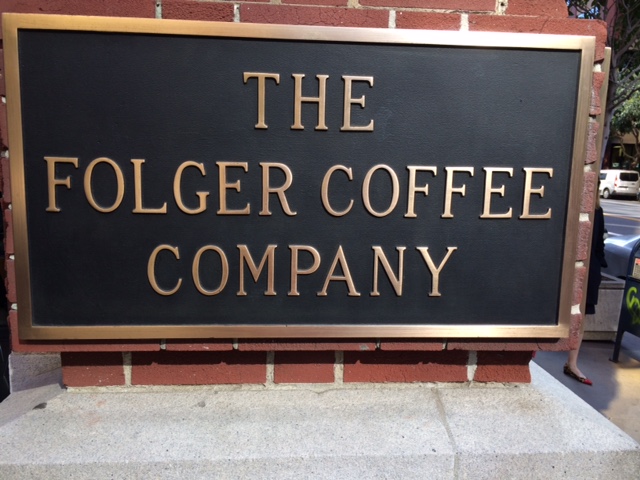
Fig. 10. J. A. Folger office sign at corner of Howard and Spear Sts.
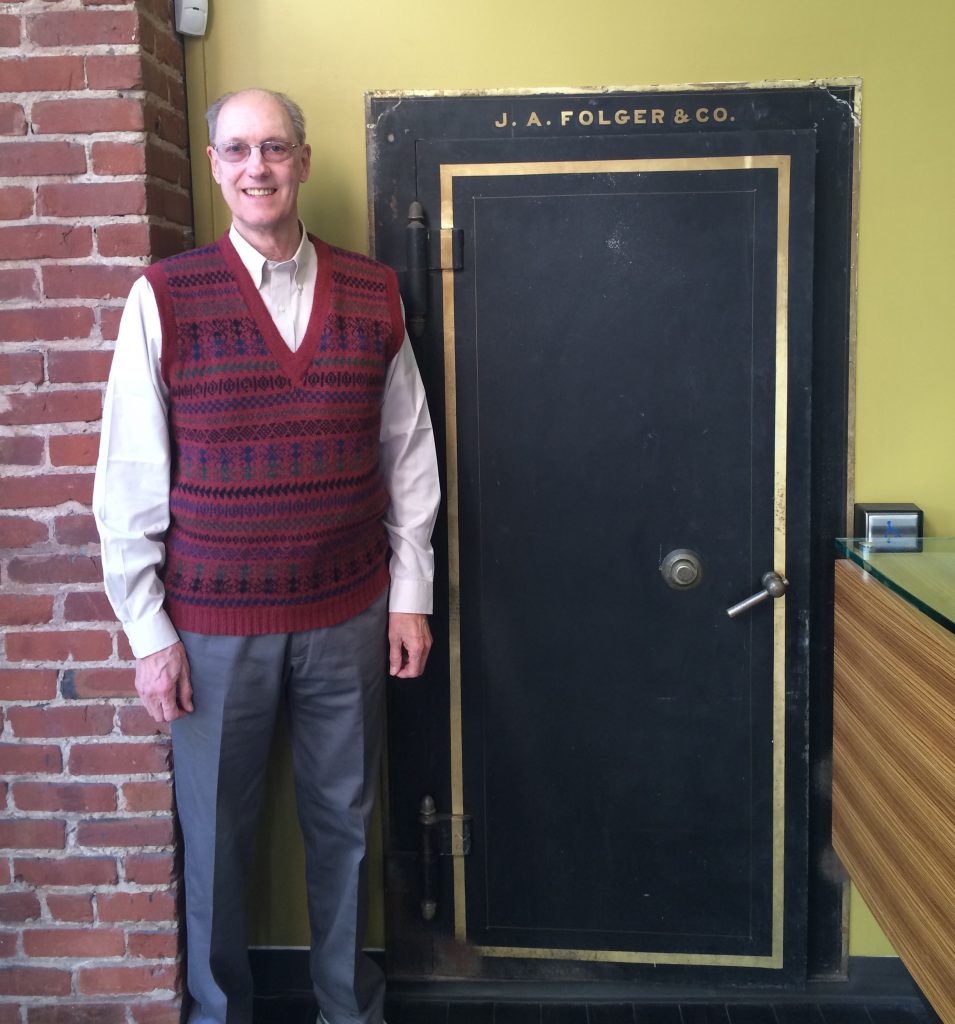
Fig. 11. Author, walk-in safe in J. A. Folger office at 101 Howard St.
Thanks to its strong construction, 101 Howard St. survived the 1906 San Francisco earthquake. U.S. Marines chose the Folger building from which to pump water from the bay to put out the spreading fires. As the city was being rebuilt, Folger’s handed out free coffee.
In the first decade of the 20th century, Folger’s company underwent substantial geographical expansion. Starting out on the west coast, the firm added plants in the Midwest: Fort Worth, Texas and in 1907 in Kansas City, blessed with a rail hub and port on the Missouri River. In 1908, J. A. Folger & Co. of Nevada was incorporated.
James Ahearn Folger III (1900–1972), after college in 1922, started working as a clerk for the family firm in San Francisco, now entering its third generation. He moved to the northwest to work in sales before returning to San Francisco as Advertising Manager. In 1926 he was elected Director and Vice President. A decade later he became President. During World War II metal was no long available for package coffee. The company switched to glass jars with waxed cardboard lids. In 1938, Folger’s opened a plant in Houston, Texas which received bags of green coffee that sailed 50 miles up the ship channel from Galveston. The 1930s also saw the opening of Folger’s plants south of the border, in El Salvador, Guatemala, and Mexico. By 1952 the company had added Los Angeles and Portland, Oregon to its stateside office locations.
In 1958, when the New York Giants baseball team moved to San Francisco, Folger’s Coffee became one of its three sponsors. Famed play-by-play sportscaster Russ Hodges, remembered for describing Bobby Thomson’s three-run home run against the Brooklyn Dodgers in 1951 clinching the National League pennant, also became the California voice of Folger’s.
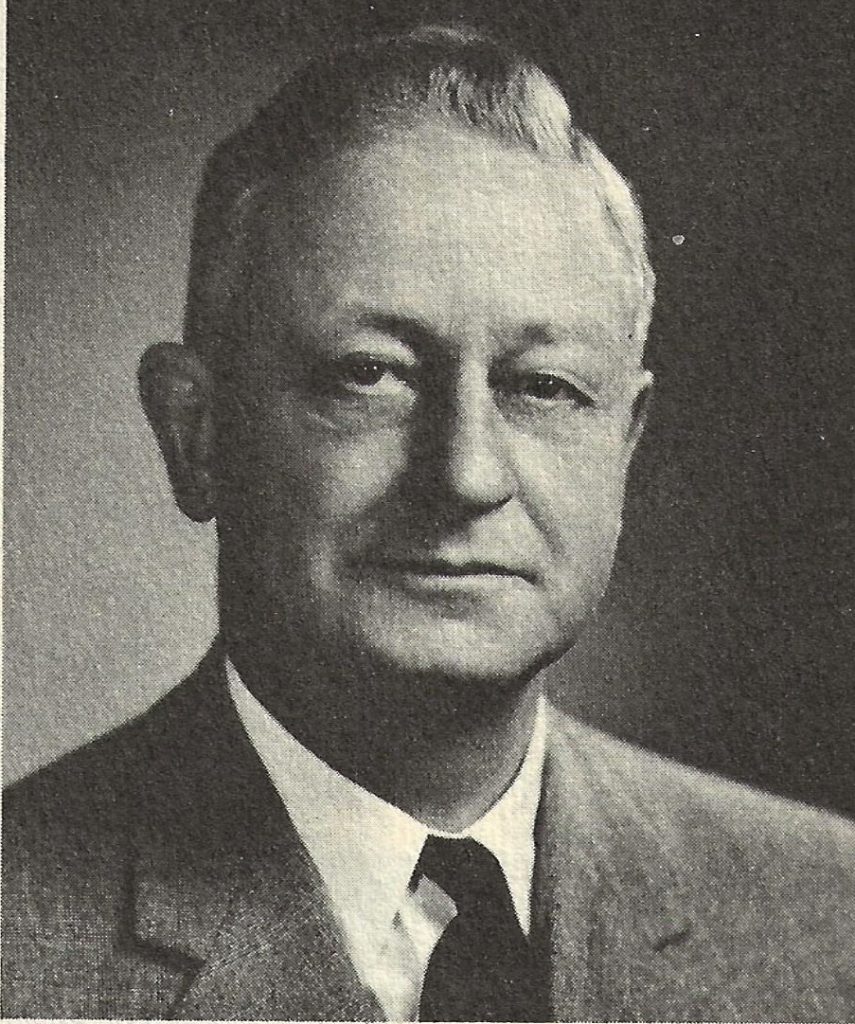
Fig. 12. James Ahearn Folger III
The Folger Way, p70
In 1963, the family heirs of James Folger II and Ernest sold the third largest coffee wholesaler in the country to Procter and Gamble. Peter Folger (1905–1980) was grandson of the founder, younger brother of James Folger III, and the father of Abigail Folger. Peter worked for the company from 1932 to 1970. Abigail was coffee heiress and at age 25 in 1969 Charles Manson family murder victim.
In 2005, exactly a century after the San Francisco earthquake, Hurricane Katrina severely damaged the New Orleans plant that Proctor & Gamble officer Jennifer Becker called “the largest coffee production plant in the United States.” The plant shut down for 11 weeks during which the company set up a “trailer village” for employee housing. In 2008, J. M. Smucker Company in Orrville, Ohio bought Folgers Coffee from P&G.
North America is the world’s largest coffee market. The Folger coffee story that began in San Francisco continues to play a lead role in the United States and beyond.
COMMENTS:
12 Comments
Submit a Comment
CONNECT

Wow, Stephen!
This is, to me, the most fascinating thing I’ve ever read from your large and growing list of wonderful writings! In fact, it may be one of the most interesting bits of research I’ve ever seen on this aspect of our family (and one embarrassing to me) because I’ve told the story of the Folger(?) Coffee connection to Nantucket Folgers to many people who have asked but I was apparently quite wrong in my retelling of the story.
Interesting history, as I drink a cup of Folgers.
Loved the blog. Did not realize it has been 70 years since that famous THE GIANTS HAVE WON THE PENNANT!
Thanks, Steve! What a great scholar/writer you are! Marge
All these articles are truly fascinating and written with great erudition!! Good on ya, as the Aussies say. Stay well and curious!
Quite a neat story, Steve
It’s all my Mum drinks, all day !
Julie DeVere, Director of Museum Collections at Filoli, found this post a “fun read,” and added that the smaller Folger’s coffee can (Figs. 4-5.) was donated by the Folger family in 2019.
Hi Stephen,
Tomorrow I return to CA; I’ve been in Boston, then Nantucket following an ancestry trail to Mary Morrill. My Morrill line comes from Abraham Morrill who landed in Boston in 1632. Brother Isaac and sister Joanna Brewer was also on board. Abe may have been too young to be listed on log but seen in Boston/Cambridge w bro and joined Ancient and Honorable Artillary in 1638. He lived in Cambridge till 1640 when he moved to Salisbury, granted land for a corn mill. His neighbor was Thos Macy. Macy and others left Salisbury in 59(?my notes are buried in my suitcases! When Abraham died unexpectedly in 1662 he was written up in Salisbury/Amesbury Records as prominent and prosperous. He had married Sarah Clements from Haverhill(side note; direct descendent of Samuel Clements!) and I believe Abe traveled between Haverhill/ Salem/ Salisbury and Boston, … we’ll, there I go again… I’ll share more if you’re interested… I have my Morrill book if interested
I did come across an index for AGrandfather for BF, written by Clarence King w wife, Alice at NHARL.. I am trying to get ahold of a copy of that book to write up a similar book about Mary’s herstory, raising her Folger Brood on MV and Nantucket (about femaleMotherperspective of home, food, childrens births, friends and neighbors) NOT 400 pages and more fiction like the dialog in Grandfather and Half Share Man.
Thx for your time and consideration.
Sincerely,
Liz Morrill Mosher
Very nicely written article. We have quite a lot of famous cousins.
It does make me crazy when people call me Folgers… I’m like, “Apos-…tro-… Phe …. S!”
I never even realized that Proctor and Gamble had removed it… sigh.
Awesome story.
I loved it and possibly my family story as well. Lol
The history is unbelievable and thank you for bringing it to light.
Wow Stephen I am so excited to read about my family. I grew up not knowing my family and have recently found that Peter Folger (B.1617) is my 9th Great-Grandfather. I so appreciate everything you have done in collecting the history of my family.